19 Types of Black Birds in Mississippi (With Pictures)
Last Updated on
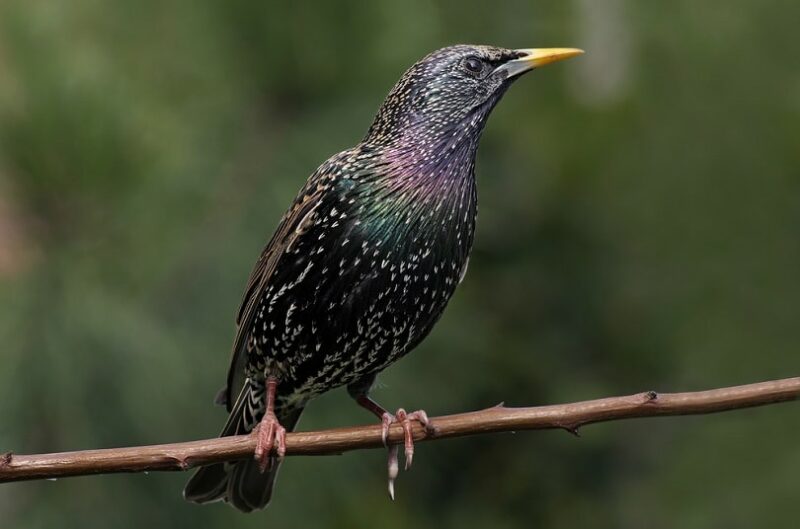
Although they are given the name blackbirds, some of these sweet songbirds are brightly colored and are all part of the Icteridae family.
Mississippi is home to various blackbirds and is a birdwatcher’s dream. While some are easily identifiable, others can only be recognized at a close distance. Some are commonly spotted, while others are extremely rare.
We put together a list of blackbirds you can find in Mississippi, so you can identify them and invite some of them to your backyard.

The 19 Types of Black Birds in Mississippi
1. Red Winged Blackbird
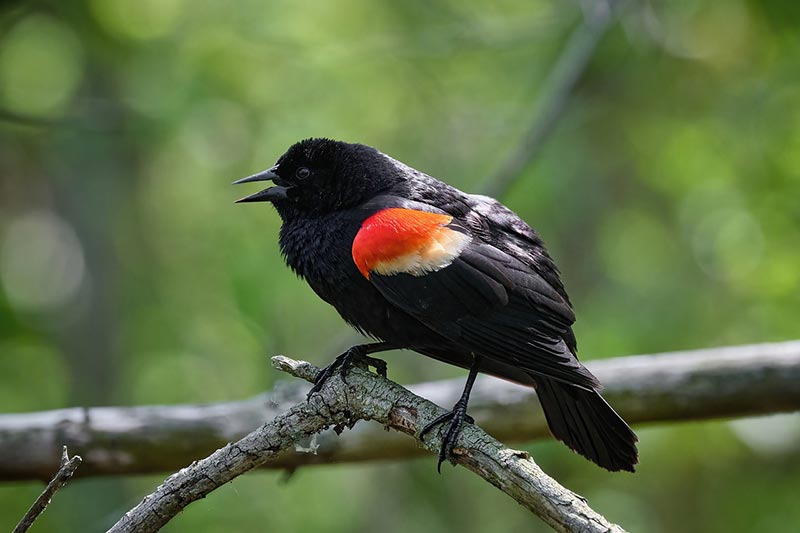
| Scientific name | Agelaius phoeniceus |
| Identifying characteristics | All black with red patches on wings |
| Wingspan | 12.2–15.8 inches |
Red-winged blackbirds are active in Mississippi throughout the year and are easy to spot with their black bodies and bright red/orange patches on their wings. Female birds are more difficult to identify because they are duller and have a streaky brown and white coloring that may look like a sparrow. They are often seen in marshy reeds as they prefer wet areas but can also be spotted perched on telephone wires and farm fields.
Their diet consists of insects in the summer and primarily seeds in the winter. They can be attracted to your backyard by simply spreading a mix of seeds and grains on the floor or feeder.
Interesting Fact: The oldest recorded red-winged blackbird to live in the wild lived for 15 years and 9 months.
2. Rusty Blackbird
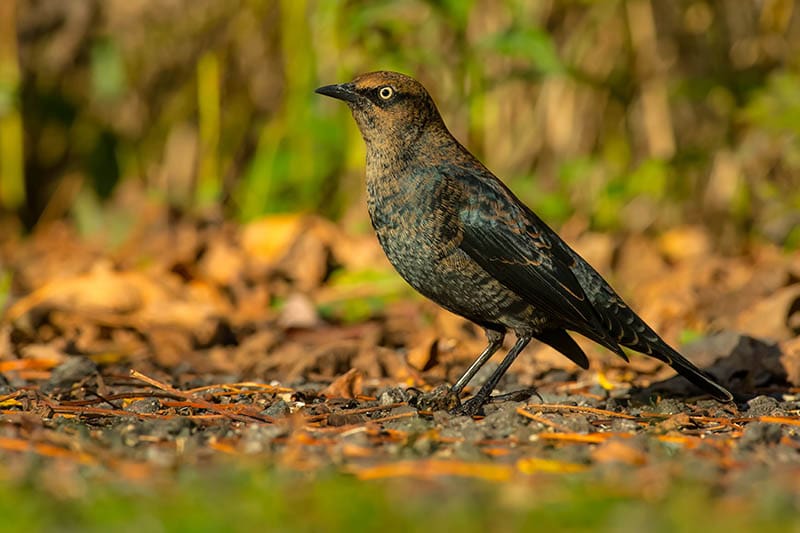
| Scientific name | Euphagus carolinus |
| Identifying characteristics | Medium-sized with narrow bills |
| Wingspan | 14.6 inches |
Rusty Blackbirds can be found in Mississippi during the winter and have declined by 85% in the last 40 years for unknown reasons. December through to March are the best times to spot them, and during the non-breeding season, they can be seen near wetlands, marshes, and sometimes meadows.
The males are glossy black when breeding and more of a rusty brown like the females when they are not breeding. The females also have pale eyebrows that contrast against the black feathers that surround the eyes. Most of their annual diet consists of insects, seeds, grains, and berries.
Interesting Fact: The Rusty blackbird sometimes attacks and eats other birds.
3. Brewer’s Blackbird
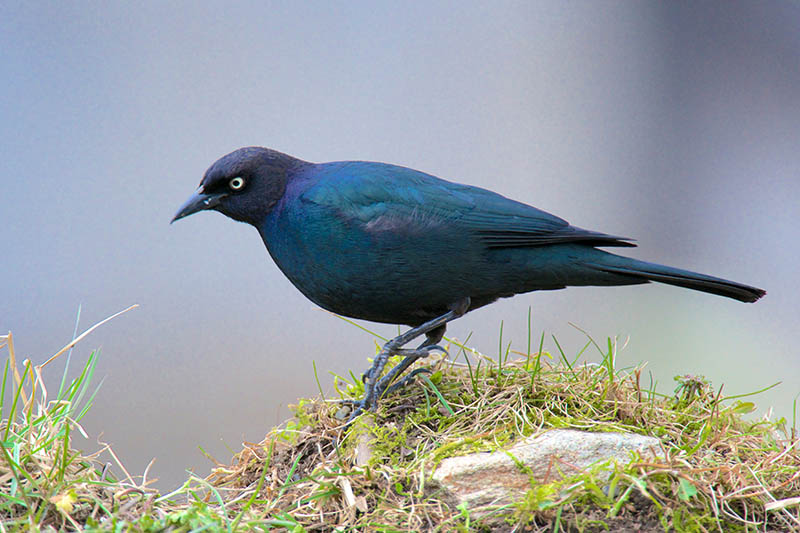
| Scientific name | Euphagus cyanocephalus |
| Identifying characteristics | Males are glossy black with metallic green, purple and blue that reflects in the sun |
| Wingspan | 7.9–8.7 inches |
The breeding season is the most common time you will spot the Brewer’s blackbird in Mississippi. They are medium-sized birds, and while the males are glossy black with some metallic spots of color, the females are plain brown all over their bodies. They live in various habitats, including marshes, woodlands, farmlands, coasts, and parks.
They are social birds seen in flocks of up to 100 pairs of birds. Their diet consists of grains, seeds, and insects, and you can attract them to your yard by providing millet, cracked corn, and sunflower seeds on your ground feeder.
Interesting Fact: A group of Brewer’s blackbirds is known as a “keg” of blackbirds.
4. Brown-headed Cowbird
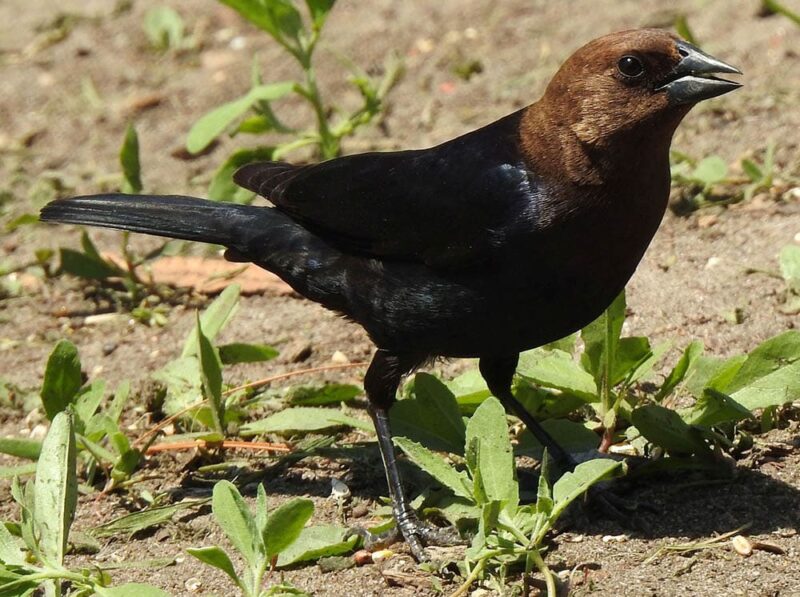
| Scientific name | Molothrus after |
| Identifying characteristics | Brown, stocky bird with a thick cone-like bill and short tails |
| Wingspan | 6.3–7.9 inches |
Brown-headed cowbirds can be found all year round in Mississippi. They are commonly found in grasslands and fields, mostly at ground level, looking for food. As their name suggests, they have chocolate brown heads that contrast their black bodies. The females are smaller and harder to identify, with brown bodies all over and a faint streaking.
They mainly feed on seeds and grass but still enjoy insects. The females also eat eggs and their shells for calcium. They don’t build their nests but use the nests of other birds to deposit their eggs and let the other bird do all the work! They eat mostly seeds and fruit, as well as spiders, grasshoppers, and beetles.
Interesting Fact: They got their name because they follow the bison on North America’s Great Plains eating insects that are kicked up by the cattle.
5. Bronzed Cowbird

| Scientific name | Molothrus aeneus |
| Identifying characteristics | Dark glossy black feathers with bright red eyes |
| Wingspan | 7.9 inches |
Bronzed cowbirds are rarely seen in Mississippi and generally visit between 4 to 8 years in a 10-year period. When these birds are young, they are brown, and as they mature, they turn black. The males also have bright red eyes, making them easy to identify when seen at a close distance.
The females are brown in color with brown eyes. The males also have a thick nape and usually puff out their nape feathers to attract a mate. Their diet consists of insects, seeds, and grains, and they are generally attracted to backyard feeders. However, they are brood parasites, so they may steal the nests of your resident backyard birds.
Interesting Fact: The females will lay their eggs in the nests of over 220 bird species.
6. Shiny Cowbird
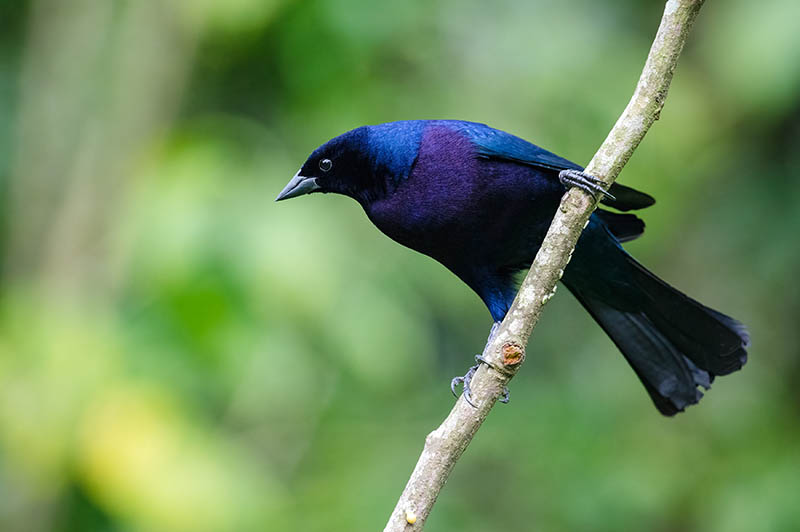
| Scientific name | Molothrus bonariensis |
| Identifying characteristics | Dark and glossy, velvety purple |
| Wingspan | 11 inches |
Shiny cowbirds are an accidental species in Mississippi and are mainly found in South America. The male’s feathers are a dark velvety purple which can look black when seen from far, while the female resembles the brown-headed cowbird. Shiny cowbirds forage with other blackbird species and eat grains, seeds, and insects from the ground. They are also brood parasites that lay their eggs in the nests of other birds and never build their own.
Interesting Fact: Populations of the shiny cowbird are increasing, and their range is expanding.
7. Bobolink

| Scientific name | Dolichonyx oryzivorus |
| Identifying characteristics | Pale yellow hair-like patch on the back of their heads |
| Wingspan | 10.6 inches |
During the spring and fall migration, Bobolinks can be spotted in Mississippi and are most common in May. Breeding males are easily identifiable because of the pale-yellow section on the back of their heads that resembles hair. Males that aren’t breeding and females look somewhat different. They are brown, streaked with stripes down their crowns, and quite plain in their appearance.
They are found in open grasslands during the breeding season and marshy and coastal areas after the breeding season. They will feed on weed seeds and insects during the breeding season and feed their nestlings exclusively with invertebrates. During winter and migration, they mostly eat rice, small grains, and occasionally insects. If there are overgrown fields near your home, they may visit your backyard in search of seed-bearing weeds.
Interesting Fact: Bobolinks travel 12500 miles to and from South America every year, traveling the equivalent of 4-5 times the circumference of the Earth.
8. Boat-Tailed Grackle

| Scientific name | Quiscalus major |
| Identifying characteristics | Glossy black birds with long legs, long tails, long bills |
| Wingspan | 15.3–19.7 inches |
These birds are not common in Mississippi and are restricted to salt marshes along the coastline. The males are blue/ black and glossy, with long tails, long legs, and long bills, while the females are almost half the size of their counterparts, and their backs are dark brown with a paler brown on the underside.
They will feed on any scraps they can find, from seeds to crustaceans, and are often seen in beach parks and towns foraging for scraps.
Interesting Fact: If the grackle falls in the water, it can swim for short distances using its wings as paddles.
9. Common Grackle
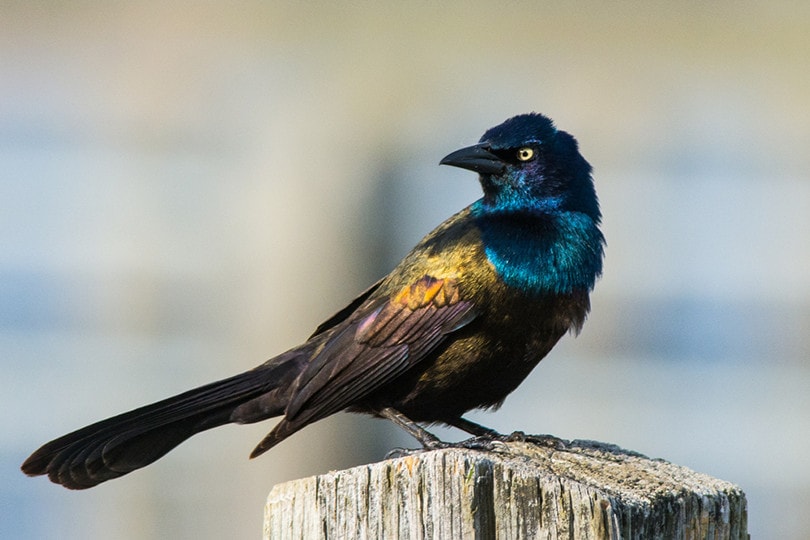
| Scientific name | Quiscalus quiscula |
| Identifying characteristics | Glossy, metallic bodies, taller than other blackbirds |
| Wingspan | 14.2–18.1 inches |
Despite being a near-threatened species, Common Grackles are the third most commonly spotted bird during the winter and the fourth most common blackbird in Mississippi during the summer.
Common grackles are typically taller than other blackbirds and have longer tails. The males are glossy and metallic, while the females are smaller with a brown body that is less glossy. They eat a variety of crops, primarily corn, and congregate in noisy groups high up in trees. Common grackles can be aggressive and noisy, and they eat garbage.
Interesting Fact: Anting is a practice in which the Common Grackle allows ants to crawl over its body to secrete formic acid, which is thought to kill parasites.
10. Great-tailed Grackle

| Scientific name | Quiscalus mexicanus |
| Identifying characteristic | Long-legged birds with long tails. Males are black with yellow eyes. |
| Wingspan | 18.9–22.8 inches |
Great-tailed grackles are rare in Mississippi but are classified and accepted as an accidental species by the Mississippi Ornithological Society.
Male great-tailed grackles are slender, long-legged blackbirds with a flat-headed profile and straight bills. They have feathers that are blue-black and bright yellow eyes. The male’s tail is tapered, folds into a distinctive V shape, and is nearly as long as its body, hence its name. The females are approximately half the size of males with longer and more slender tails. They are dark brown on the back and lighter brown underneath.
They feed on seeds, grains, fruit, worms, spiders, snails, and other insects. They are frequently seen with other blackbirds pecking for food on lawns and marsh edges.
Interesting Fact: Great-tailed grackles are social and loud birds that can form flocks of ten thousand birds.
11. European Starling
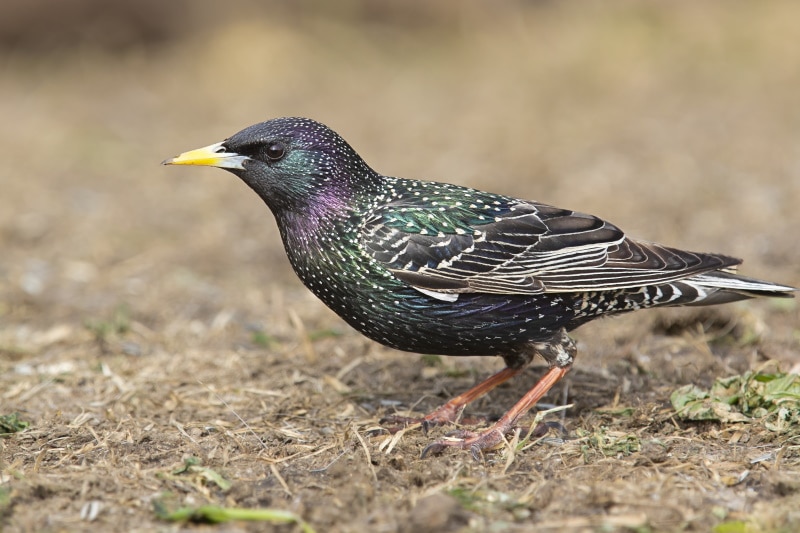
| Scientific name | Sturnus vulgaris |
| Identifying characteristic | Iridescent purple, blue and green tones. |
| Wingspan | 12.2–15.8 inches |
European starlings are a species that were introduced to Mississippi. They can be seen throughout the year and do not migrate.
European starlings were introduced to North America in the 19th century by Shakespeare enthusiasts and are now among the continent’s most numerous songbirds. They are small and stocky with beautiful metallic colors, and in winter, they are covered in white spots.
Starlings are common in urban and suburban areas. You will see them moving across the grass in a zig-zag pattern, appearing to hurry as they pierce their bills into the ground. The species frequently visit bird feeders, flies in large, noisy flocks, and is considered a pest due to their aggressive behavior.
Interesting Fact: North America is home to approximately 200 million European starlings. All are descended from 100 starlings released in New York City between 1890 and 1891.
12. Yellow-Headed Blackbird
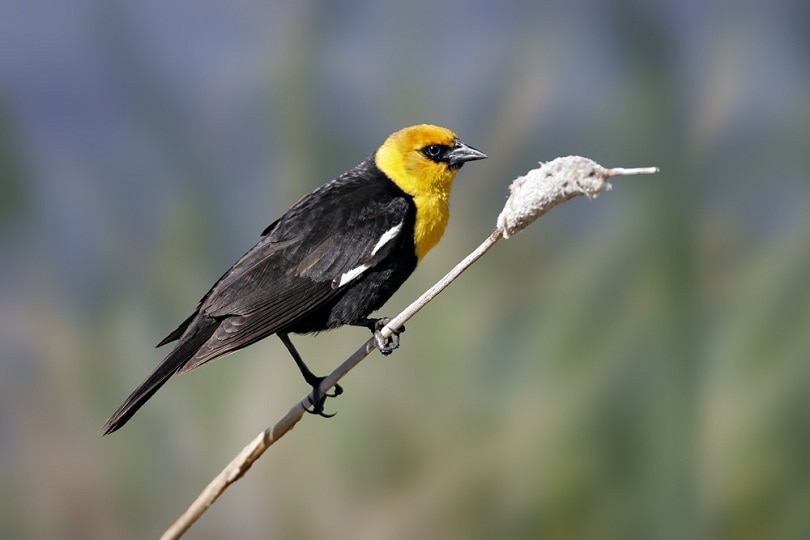
| Scientific name | Xanthocephalus xanthocephalus |
| Identifying characteristics | Black with golden yellow head |
| Wingspan | 16.5–17.3 inches |
These striking birds demand attention with their golden yellow heads and chests that stand out against their glossy black bodies. The male’s wings have white patches, and the females are brown with a paler yellow head. They can be seen near freshwater wetlands and farm fields close by, and although they are easy to identify, they are usually out of view and found by listening to their calls.
Yellow-headed blackbirds feed on grains in winter and insects in summer and may visit backyard feeders to enjoy sunflower seeds and grains.
Interesting Fact: Yellow-headed blackbirds always build their nests over water, and the nestlings occasionally fall into it and must swim a short distance until they reach vegetation.
13. Eastern Meadowlark

| Scientific name | Sturnella magna |
| Identifying characteristic | Bright yellow underparts marked with a black V |
| Wingspan | 13.8–15.8 inches |
Eastern meadowlarks can be seen in Mississippi all year and are considered a near-threatened species. Eastern Meadowlarks are medium-sized songbirds with chunky bodies, short tails, and long, spear-shaped bills. They are pale brown with black markings and have bright yellow underparts and a large black V across the chest. Their rounded wings, short tails, and long bills distinguish them from other grassland songbirds when in flight. Their flight is characterized by rapid fluttering and short glides, and they usually fly low to the ground. They can also be seen walking on the ground, often hidden by grasses or crops. In the winter, flocks can be seen hunting insects in fields. Males sing beautiful songs from exposed perches.
Interesting Fact: A group of meadowlarks is collectively known as a “pod” of meadowlarks.
14. Western Meadowlark
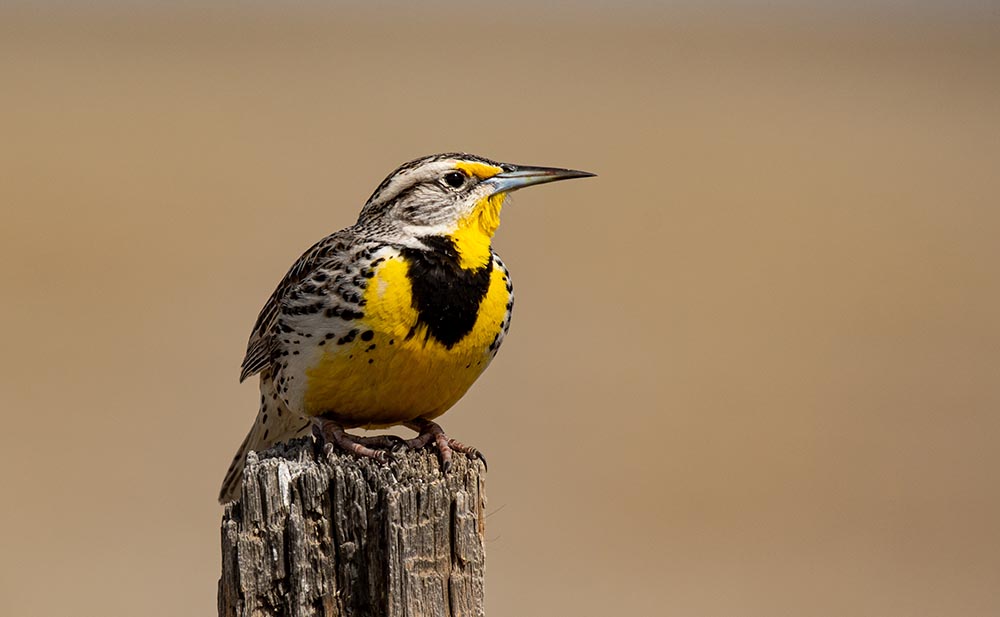
| Scientific name | Sturnella neglecta |
| Identifying characteristics | Bright yellow bellies |
| Wingspan | 16.1 inches |
Western Meadowlarks are rarely seen in Mississippi, but they are known to be common and can be seen during the winter.
Western Meadowlarks are brown with bright yellow breasts (that turn gray in the winter) marked by a distinct black V-shaped band, but unless you spot a male singing from a fence post, they are often more easily heard than seen.
Their diet consists of insects and seeds. Foraging areas include open grasslands, meadows, and fields of low-growing vegetation, as well as marshes and road edges with very little cover. If food is provided, these blackbirds may visit backyards.
Interesting Fact: Although it resembles the Eastern Meadowlark, the two species rarely mate. Mixed pairs are most common near the range’s edge, where there are few mates available.
15. Baltimore Oriole

| Scientific name | Icterus galbula |
| Identifying characteristics | Bright orange and black |
| Wingspan | 9.1–11.8 inches |
From April to September, Baltimore Orioles can be spotted in Mississippi. Although they spend most of the breeding season in the state’s northern regions, they can be seen in the south during migration.
They are usually exploring the woodland greenery or perched on upper tree branches. You won’t miss the male with his bright and brilliant orange belly that contrasts against his black wings. The females are more yellow underneath, with brown wings mixed with a hint of yellow.
The Baltimore oriole feeds on insects, fruit, and nectar. They usually seek ripe fruit, so you can halve oranges and hang them from your trees to attract them to your backyard. Planting fruit-bearing trees can also be inviting year after year.
Interesting Fact: When eating fruits, Baltimore orioles use an unusual technique known as gaping. After inserting their beaks, they spread them out to form a tunnel and lap up the juices with their tongues.
16. Orchard Oriole
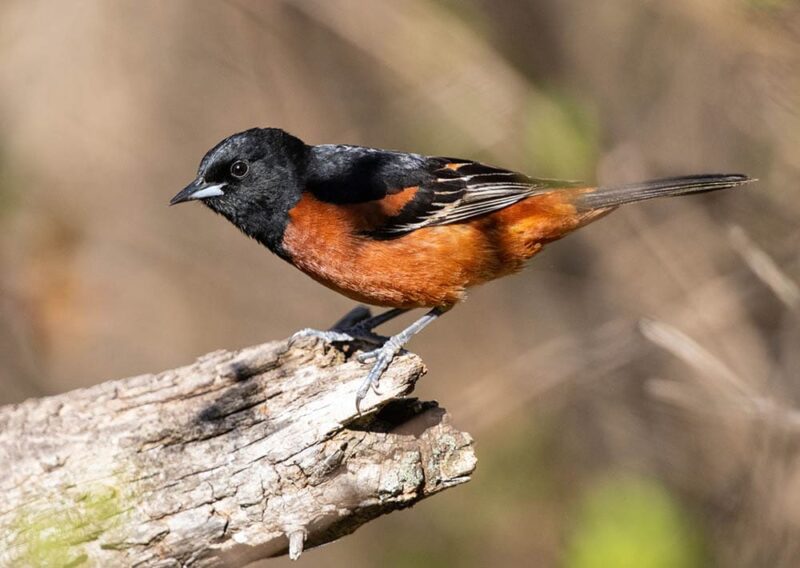
| Scientific name | Icterus spurius |
| Identifying characteristics | Males are black with red underneath. Females are green-yellow with no black. |
| Wingspan | 9.8 inches |
During the breeding season, orchard orioles have been spotted in Mississippi. They arrive as early as March, and some stay until January, but the best months to see them are from April to September. They are slim birds with rounded heads and sharp bills. The males are black with a chestnut red belly.
The females have no black and are green and yellow with two white wing bars. Orchard orioles hunt for insects in treetops, and summers are spent in open woodlands and areas with scattered trees in the eastern United States and southern Canada. They mainly eat insects, including spiders, grasshoppers, and caterpillars, and in the fall, they eat fruit and berries and drink nectar from flowers. They enjoy orange slices and jelly at backyard feeders.
Interesting Fact: The orchard oriole is the smallest oriole in North America.
17. Bullock’s Oriole

| Scientific name | Icterus bullockii |
| Identifying characteristics | Males are bright orange with black and white wings. Females have yellow heads with gray backs. |
| Wingspan | 12.2 inches |
Bullock’s Orioles are considered unintentional birds in Mississippi, and they were last seen in 2020 in the vicinity of Starkville.
They are slim, sturdy, medium-sized birds with long tails and sharp bills. The males are blazing orange with black and white wings and distinct black markings on their heads. The females are gray with yellow heads, chests, and tails. You can spot them in open woodlands and parks, foraging for insects and feeding on branches of trees and shrubs. You can also spot them sometimes hanging upside down from branches. They also enjoy fruit and nectar from flowers and can be attracted to your backyard using fruit and sugar water.
Interesting Fact: They are one of the few species capable of puncturing and ejecting the eggs of brown-headed cowbirds.
18. Hooded Oriole
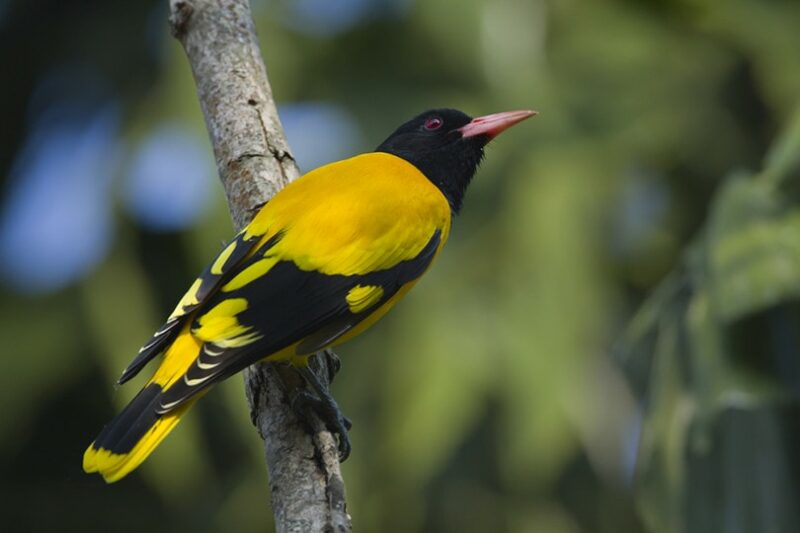
| Scientific name | Icterus cucullatus |
| Identifying characteristics | Males are bright orange with black backs and throat. Females are yellow and gray. |
| Wingspan | 9.1–11.0 inches |
Hooded Orioles are an extremely rare species in Mississippi and are classified as an accidental species. They were last spotted near Pass Christian in 2010.
The males are a beautiful bright orange with black backs and a black throat extending to their beaks. The females are duller and more yellow, and their wings are a gray tone. They also don’t have the distinct black face that the males have. They can be hard to find as they tend to stay hidden, but their whistles can be heard.
Hooded orioles live in open, dry areas of the Southwest with scattered trees, particularly palms, from which their nests are frequently seen hanging. Hooded orioles forage for insects on the undersides of leaves, eat fruit, and drink nectar from flowering plants. You can attract them to your backyard with orange slices, sugar water, or jelly.
Interesting Fact: When the nest is hanging from the palm leaves, the female pokes holes in the leaf from underneath and pushes the fibers through, sewing the nest to the leaf.
19. Altamira Oriole
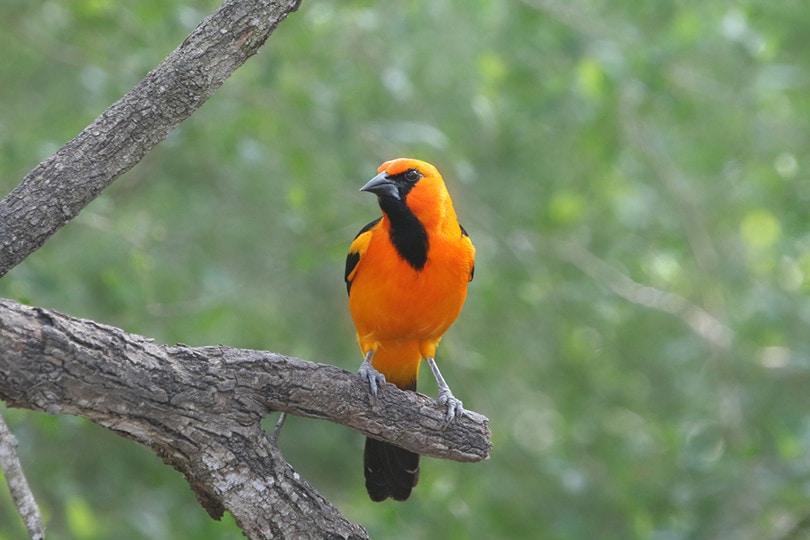
| Scientific name | Icterus gularis |
| Identifying characteristics | Black and bright yellow with black around the eyes. |
| Wingspan | 14.2 inches |
Altamira orioles are a very rare species to see in Mississippi. It is bright orange, being the brightest in the face. Their backs and tails are black with black throats that extend up to the bills and around the eyes.
Their wings are also black with white bars and orange shoulders. They can be seen in lightly wooded areas and parks and forage small insects from leaves and branches. They also enjoy nectar from flowers and can be attracted to your backyard with sunflower seeds, fruit, and sugar water.
Interesting Fact: Altamira orioles are monogamous seasonally and possibly for life. They are almost always seen in pairs of two.

Final Thoughts
Blackbirds are abundant in Mississippi. They are a variety of beautiful colors; some are easy to identify from afar, while others require a closer look or are more likely heard than seen. Some species are incredibly rare, but you never know when you may be in the right place at the right time. Although some consider the birds as pests due to their sometimes-bullying nature, they are beautiful, sweet songbirds that are a pleasure to observe.
Check out more black birds here:
- 11 Types of Black Birds in Utah
- 15 Types of Blackbirds in Kentucky
- 12 Types of Black Birds in Delaware
Featured Image Credit: arjma, Shutterstock
Table of Contents
- The 19 Types of Black Birds in Mississippi
- 1. Red Winged Blackbird
- 2. Rusty Blackbird
- 3. Brewer’s Blackbird
- 4. Brown-headed Cowbird
- 5. Bronzed Cowbird
- 6. Shiny Cowbird
- 7. Bobolink
- 8. Boat-Tailed Grackle
- 9. Common Grackle
- 10. Great-tailed Grackle
- 11. European Starling
- 12. Yellow-Headed Blackbird
- 13. Eastern Meadowlark
- 14. Western Meadowlark
- 15. Baltimore Oriole
- 16. Orchard Oriole
- 17. Bullock’s Oriole
- 18. Hooded Oriole
- 19. Altamira Oriole
- Final Thoughts
About the Author Robert Sparks
Robert’s obsession with all things optical started early in life, when his optician father would bring home prototypes for Robert to play with. Nowadays, Robert is dedicated to helping others find the right optics for their needs. His hobbies include astronomy, astrophysics, and model building. Originally from Newark, NJ, he resides in Santa Fe, New Mexico, where the nighttime skies are filled with glittering stars.
Related Articles:
Monocular vs Telescope: Differences Explained (With Pictures)
10 Types of Hummingbirds in Arkansas (With Pictures)
8 Types of Hummingbirds in Nebraska (With Pictures)
5 Types of Hummingbirds in Idaho (With Pictures)
3 Types of Hummingbirds in Mississippi (With Pictures)
8 Types of Hummingbirds in Kansas (With Pictures)
5 Types of Hummingbirds in West Virginia (With Pictures)
5 Types of Hummingbirds in Ohio (With Pictures)
